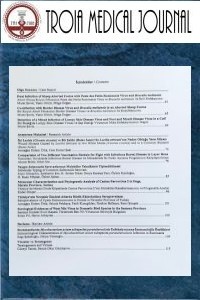COVID-19 pandemi döneminde koroner arter hastalığına hibrit yaklaşım
koroner arter hastalığı, koroner bilgisayarlı tomografi anjiyografi, COVID-19
Hybrid Approach to Coronary Artery Disease During the COVID-19 Pandemic Period
___
- 1. Maurya VK, Ravikumar R, Sharma P, et al., Coronary CT angiography: A retrospective study of 220 cases. Med J Armed Forces India. 2016 Oct;72(4):377-383. doi: 10.1016/j.mjafi.2016.03.008. Epub 2016 May 26. PMID: 27843187; PMCID: PMC5099437.
- 2. Knuuti J, Wijns W, Saraste A, et al.; ESC Scientific Document Group. 2019 ESC Guidelines for the diagnosis and management of chronic coronary syndromes. Eur Heart J. 2020 Jan 14;41(3):407-477. doi: 10.1093/eurheartj/ehz425. PMID: 31504439.
- 3. Elliott JM, Crozier IG. Decreases in cardiac catheter laboratory workload during the COVID-19 level 4 lockdown in New Zealand. Intern Med J. 2020 Aug;50(8):1000-1003. doi: 10.1111/imj.14922. PMID: 32881225; PMCID: PMC7436864.
- 4. Sun Z, Almutairi AM. Diagnostic accuracy of 64 multislice CT angiography in the assessment of coronary in-stent restenosis: a meta-analysis. Eur J Radiol. 2010;73(2):266–273.
- 5. Raff GL, Chinnaiyan KM, Cury RC, et al. SCCT guidelines on the use of coronary computed tomographic angiography for patients presenting with acute chest pain to the emergency department: a report of the Society of Cardiovascular Computed Tomography Guidelines Committee. J Cardiovasc Comput Tomogr. 2014; 8:254–271
- 6. Cho I, Chang HJ, Sung JM, et al. Coronary computed tomographic angiography and risk of all-cause mortality and nonfatal myocardial infarction in subjects without chest pain syndrome from the CONFIRM Registry (coronary CT angiography evaluation for clinical outcomes: an international multicenter registry). Circulation. 2012;126 (3):304–313.
- 7. Mowatt G, Cook JA, Hillis GS, et al. 64-Slice computed tomography angiography in the diagnosis and assessment of coronary artery disease: systematic review and meta-analysis. Heart. 2008;94:1386–1393. doi: 10.1136/ hrt.2008.145292.
- ISSN: 2630-6107
- Yayın Aralığı: Yılda 3 Sayı
- Başlangıç: 2019
- Yayıncı: Çanakkale Onsekiz Mart Üniversitesi
Akut miyokard infarktüsü ile başvuran bir COVID-19 hastasına yaklaşım
Ali DUYGU, Uğur KÜÇÜK, Mehmet ARSLAN
Hakan KARTAL, Özgür ÖZERDOĞAN, Gamze ÇAN, Coşkun BAKAR
Tıp öğrencilerinin tıbbi mikrobiyoloji uzmanlık dalı hakkındaki bilgi düzeylerinin araştırılması
Deniz GAZEL, Hadiye DEMİRBAKAN
Unutulmaması gereken hastalık: COVID 19 pnömonisine eşlik eden bir subakut tiroidit
Sevil ALKAN ÇEVİKER, Safiye Bilge GÜÇLÜ KAYTA, Alper ŞENER
COVID-19 pandemi döneminde koroner arter hastalığına hibrit yaklaşım
Ali DUYGU, Bahadır KIRILMAZ, Mustafa REŞORLU
Araştırma görevlisi hekimlerin empati düzeyleri
Aylin ASA AFYONCU, Başak KORKMAZER, Banu SARIGÜL, Erkan Melih ŞAHİN
Serebral ven trombozlu hastaların etiyolojik, topografik ve klinik değerlendirilmesi
Suna AŞKIN TURAN, Şule DEVECİ, Canan BOLCU EMİR, Cihat ÖRKEN
COVID-19 pandemisinin kardiyovasküler sistem üzerine etkileri
